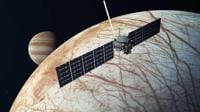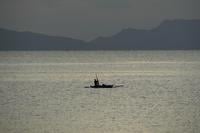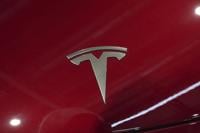CAPE CANAVERAL, Fla. (AP) — A NASA spacecraft has set sail for Jupiter and its moon Europa, one of the best bets for finding life beyond Earth.
Europa Clipper will peer beneath the where an ocean is thought to be sloshing fairly close to the surface. It won’t search for life, but rather determine whether conditions there could support it. Another mission would be needed to flush out any microorganisms lurking there.
“It’s a chance for us to explore not a world that might have been habitable billions of years ago, but a world that might be habitable today — right now,” said program scientist Curt Niebur.
Its massive solar panels make Clipper the biggest craft built by NASA to investigate another planet. It will take 5 1/2 years to reach Jupiter and will sneak within 16 miles (25 kilometers) of Europa's surface — considerably closer than any other spacecraft.
Clipper lifted off Monday aboard SpaceX’s Falcon Heavy rocket from NASA’s Kennedy Space Center. Mission cost: $5.2 billion.
Europa, the superstar among Jupiter’s many moons
One of Jupiter’s 95 known moons, Europa is almost the size of our own moon. It's encased in an ice sheet estimated to be 10 miles to 15 miles or more (15 kilometers to 24 kilometers) thick. Scientists believe this frozen crust hides an ocean that could be 80 miles (120 kilometers) or more deep. The Hubble Space Telescope has spotted what appear to be geysers erupting from the surface. Discovered by Galileo in 1610, Europa is one of the four so-called Galilean moons of Jupiter, along with Ganymede, Io and Callisto.
Seeking conditions that support life
What type of life might Europa harbor? Besides water, organic compounds are needed for life as we know it, plus an energy source. In Europa’s case that could be thermal vents on the ocean floor. Deputy project scientist Bonnie Buratti imagines any life would be primitive like the bacterial life that originated in Earth’s deep ocean vents. “We will not know from this mission because we can’t see that deep,” she said. Unlike missions to Mars where habitability is one of many questions, Clipper’s sole job is to establish whether the moon could support life in its ocean or possibly in any pockets of water in the ice.
Supersized spacecraft
When its solar wings and antennas are unfurled, Clipper is about the size of a basketball court — more than 100 feet (30 meters) end to end — and weighs nearly 13,000 pounds (6,000 kilograms). The supersized solar panels are needed because of Jupiter’s distance from the sun. The main body — about the size of a camper — is packed with nine science instruments, including radar that will penetrate the ice, cameras that will map virtually the entire moon and tools to tease out the contents of Europa’s surface and tenuous atmosphere. The name hearkens to the swift sailing ships of centuries past.
Circling Jupiter to fly by Europa
The roundabout trip to Jupiter will span 1.8 billion miles (3 billion kilometers). For extra oomph, the spacecraft will swing past Mars early next year and then Earth in late 2026. It arrives at Jupiter in 2030 and begins science work the next year. While orbiting Jupiter, it will cross paths with Europa 49 times. The mission ends in 2034 with a planned crash into Ganymede — Jupiter’s biggest moon and the solar system's too.
Europa flybys pose huge radiation risk
There’s more radiation around Jupiter than anywhere else in our solar system, besides the sun. Europa passes through Jupiter’s bands of radiation as it orbits the gas giant, making it especially menacing for spacecraft. That’s why Clipper’s electronics are inside a vault with dense aluminum and zinc walls. All this radiation would nix any life on Europa’s surface. But it could break down water molecules and, perhaps, release oxygen all the way down into the ocean that could possibly fuel sea life.
Earlier this year, NASA was in a panic that the spacecraft's many transistors might not withstand the intense radiation. But after months of analysis, engineers concluded the mission could proceed as planned.
Other visitors to Jupiter and Europa
NASA’s twin Pioneer spacecraft and then two Voyagers swept past Jupiter in the 1970s. The Voyagers provided the first detailed photos of Europa but from quite a distance. NASA’s Galileo spacecraft had repeated flybys of the moon during the 1990s, passing as close as 124 miles (200 kilometers). Still in action around Jupiter, NASA’s Juno spacecraft has added to Europa’s photo album. Arriving at Jupiter a year after Clipper will be the European Space Agency’s Juice spacecraft, launched last year.
Ganymede and other possible ocean worlds
Like Europa, Jupiter’s jumbo moon Ganymede is thought to host an underground ocean. But its frozen shell is much thicker — possibly 100 miles (160 kilometers) thick — making it tougher to probe the environment below. Callisto’s ice sheet may be even thicker, possibly hiding an ocean. Saturn’s moon Enceladus has geysers shooting up, but it’s much farther than Jupiter. Ditto for Saturn’s moon Titan, also suspected of having a subterranean sea. While no ocean worlds have been confirmed beyond our solar system, scientists believe they’re out there — and may even be relatively common.
Messages in a cosmic bottle
Like many robotic explorers before it, Clipper bears messages from Earth. Attached to the electronics vault is a triangular metal plate. On one side is a design labeled “water words” with representations of the word for water in 104 languages. On the opposite side: a poem about the moon by U.S. poet laureate Ada Limon and a silicon chip containing the names of 2.6 million people who signed up to vicariously ride along.
___
The Associated Press Health and Science Department receives support from the Howard Hughes Medical Institute’s Science and Educational Media Group. The AP is solely responsible for all content.








































